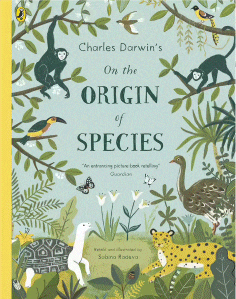
On The Origin of Species
On The Origin of Species
Sabrina Radeva & Charles Darwin
Puffin, 2022
56pp., pbk., RRP $A16.99
9780141388519
On The Origin of Species has been the definitive explanation of the theory of evolution since it was first published in 1859.
Pulling together Charles Darwin’s observations from his travels around the world and his groundbreaking – and controversial – explanation of how species form, develop and change over hundreds of thousands of years, On The Origin of Species is as relevant and important now as it ever was.
So, this first ever picture-book retelling of Darwin’s work through stylish illustrations and a simple, easy-to-understand text brings evolution to the younger generation. Interspersed with relevant quotes from Darwin himself, and accompanied by many illustrations, this is a sample explanation demonstrating its ease of access…
“For most of human history, many people believed that everything in the world was created all at once. They thought that plants. animals. and people were always the same as they were now. But there were a few clever and curious scientists [such as Georges-Louis de Buffon and Jean-Baptiste Lamarck] who challenged this idea… ” But it was the travels and studies of Charles Darwin whose work and theories have endured. “In his book, Darwin explains that species are groups of living things that look alike and can have babies together, But even if they belong to the same species, no two animals are exactly the same.”
Even for those who have different beliefs about life’s first beginnings, this is a must-have in the school library’s collection if we are to provide students with a variety of viewpoints, and it is the perfect adjunct to those books that I’ve reviewed so far this year that may have created a curiosity about this planet and its inhabitants…
BANG! The Story of How Life on Earth Began
Australian Backyard Naturalist
We are One: How the World Adds Up
The Amazing Meals of Martha Maloney
It also helps them understand all those books that have the “same but different” theme – having explored this work, they will understand the why that underpins the message. It encourages them to develop their own powers of observation and thus the discoveries they make so as well as comprehensive teachers’ notes , the endpapers also offer an immediate challenge. As well as the narrative, the book also includes an appendix (unusual in a primary-school text), a glossary and other elements that underpin the development of information literacy skills.
While, for some, this book may raise more questions than it answers, it is nevertheless an important addition to the library’s collection as we cater for those with a deep-seated curiosity about where they have come from.
